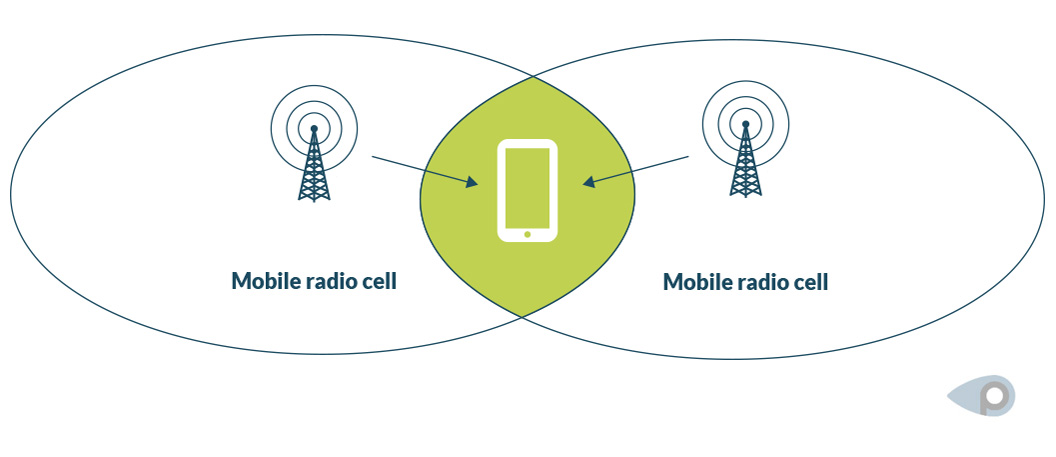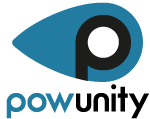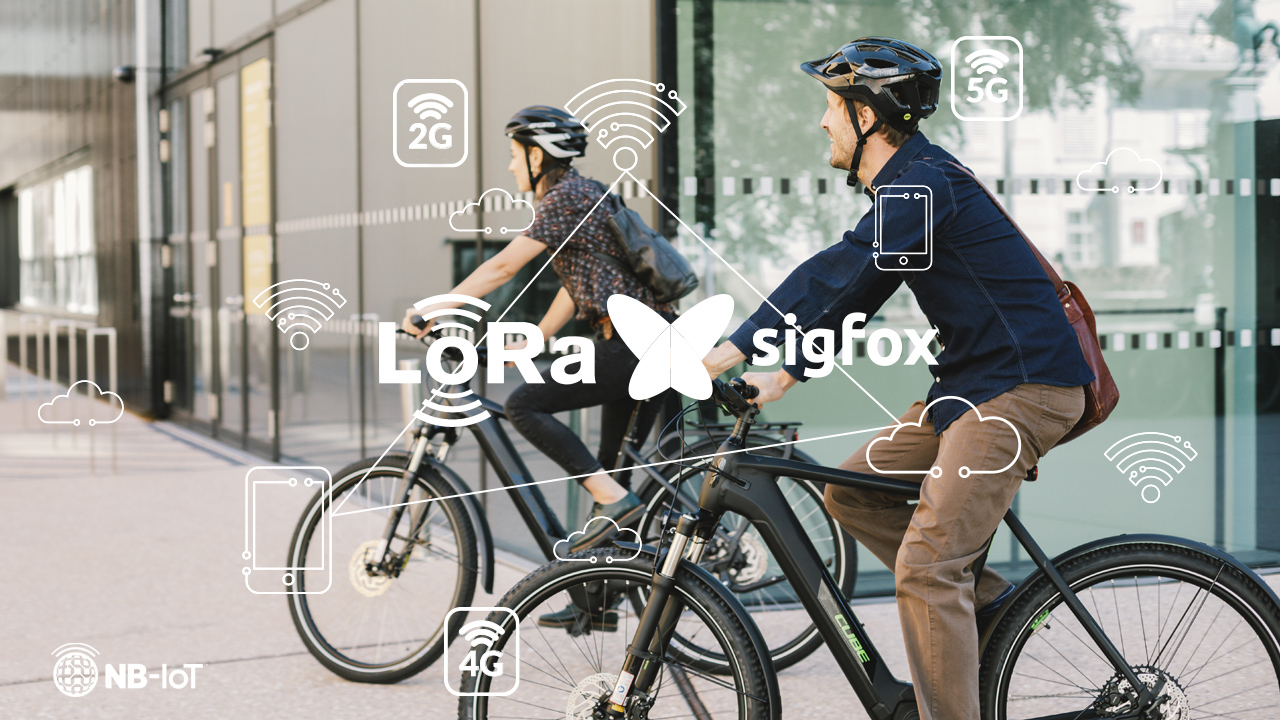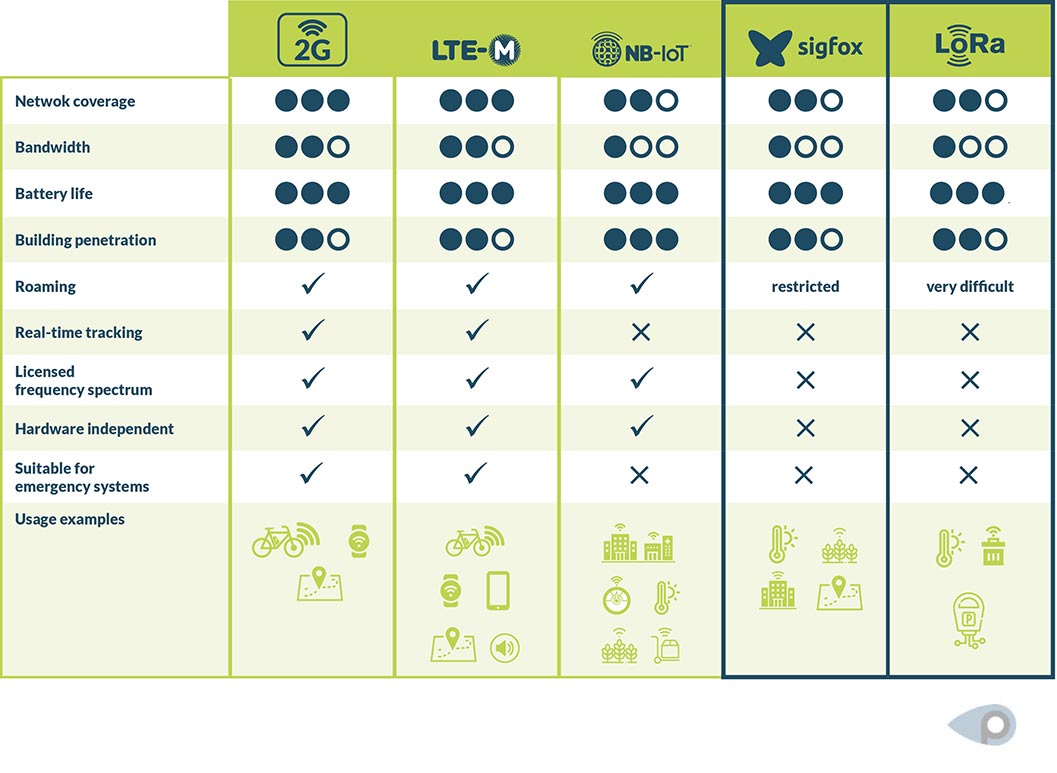- Free shipping from 220€The order of accessories (without BikeTrax) is excluded from the free shipping costs.
PowUnity explains, Special Topic, Topics
Sigfox, LoRa – Independent radio networks for data exchange? That’s what’s behind it!
Inhalt
Sigfox and LoRa in a nutshell
- SigFox and LoRa are Low Power Wide Area Networks (LPWAN), transmission technologies with a long range and low energy requirements that are used in IoT applications. They are characterised by the fact that they use free frequency bands. This means they are generally inexpensive to use.
- SigFox differs from LoRa in that it is based on existing infrastructure. This can be an advantage, but also a disadvantage, for example when transporting sensitive data.
- SigFox and LoRa are suitable for many smart city applications, as well as selected tracking solutions. However, neither technology can be used to track stolen items such as bicycles or e-bikes in real time.
When people talk about transmission technologies in the Internet of Things, the terms SigFox and LoRa often come up alongside LTE-M and NB-IoT. Both LPWAN technologies are not new, but they are different.
Above all, they differ from the competition in one central point: they use the unlicensed frequency spectrum. That has advantages and disadvantages.
IoT, LoRa, SigFox: definitions and properties
What does IoT mean?
We speak of the Internet of Things when devices or machines are networked with each other in such a way that they exchange data and partly perform actions based on this data. Smart home technologies are a well-known example of this. For example, a sensor measures the temperature and sends the measured data to a thermostat. Depending on the information it receives, the thermostat turns the heating up or down.A step further is the so-called smart city, in which streetlights, for example, can be controlled remotely. In industry, machines are networked to optimise production processes. The tracking of mobile objects by means of GPS also falls into the area of IoT or M2M (Machine2Machine).
The Internet of Things already plays an important role in many modern societies. Its importance is likely to increase in the future.In order for this data exchange to function, a transmission technology is required in addition to components such as sensors, devices and servers. More precisely, there are several.
Want to learn more about IoT? Then read our article “Internet of Things, Bikes and GPS Tracking: The Future is Connected!” Here, we go into detail about what IoT means, how different technologies for networking work and what role GPS tracking plays.
Transmission technologies for IoT applications – what SigFox and LoRa have in common
SigFox and LoRa are transmission technologies that are used in the Internet of Things to network devices and transport data. They are often mentioned in the same breath because they have a lot in common.
Besides these similarities, there are some differences.
- Both belong to the Low Power Wide Area Networks (LPWAN). This means they have low energy consumption and a long range, but can only transport small amounts of data. This distinguishes them from Bluetooth, EnOcean or WLAN, which are mainly used in the smart home sector to network lighting, heating or entertainment products over short distances.
- AIn addition, LoRa and Sigfox use free frequency bands. There are no licence fees or roaming charges for these. This does not mean that use is always free, depending on who provides the necessary infrastructure. But as a rule it is cheap.

Interesting to know: Licence-free frequency bands differ depending on the region. In Europe, different frequencies are used than in Asia or the USA.
Widespread and versatile – What is SigFox?
SigFox is the French company of the same name, founded in 2009. It proudly markets its “0G network” as “the world largest IoT network”.
To achieve high coverage, SigFox works with local network operators in various countries, and very successfully at that. According to its own information, the standard achieves a coverage of 90 per cent in Germany and is available in 72 countries. Some large companies use the technology for tracking goods, for example.
One advantage of this is that because there are no frequency costs, it is very cheap to operate. However, SigFox limits data transmission to 140 data transmissions per day and 12 bytes per message. In addition, customers have to buy new hardware when they change providers.
Finally, there are other potential disadvantages, which we discuss separately.
Independent networks for data exchange – What is LoRa?
LoRa is an acronym for “Long Range”. The technology was developed by Semtech from California, and is distributed by the LoRa Alliance, a non-profit organisation that now consists of around 500 companies.
Excursion – the difference between LoRa and LoRaWan:
Although often used as a synonym, LoRa and LoRaWan are not the same thing. The former means “only” the radio technology, LoRaWan stands for the complete network infrastructure. Central components of a LoRaWan network are servers, gateways and sensors. Basic software modules are available free of charge.
Like SigFox, LoRaWan is aimed at users who want to network devices over long distances and send small data packets. However, in this case they have to set up their own infrastructure or cooperate with local providers. This is why the standard is preferably used in spatially limited areas.
A potential advantage of LoRa is its high data security. With your own LoRaWan network, you can ensure that critical data does not leak out. You have a self-contained system. If you set up your infrastructure yourself, you don’t have to pay for the operation.
Interesting to know: The term “open” is often used in connection with LoRaWan. This is not quite correct, because for such a network you need the corresponding chip from “Semtech”. So even with LoRaWan you are dependent on a provider. In addition, there is the dependence on a certain hardware. This is usually more pronounced with transmission technologies that use the unlicensed frequency spectrum.
Sigfox and LoRa are suitable for these applications
Whether NB-IoT, SigFox, LoRa or LTE-M, each LPWAN radio standard is suitable for other applications.
Applications for SigFox
SigFox is a very versatile technology. It is used in the following areas, among others:
- Smart City: with the help of a combination of SigFox and sensors, measured values, for example on humidity or temperature, can be collected and water systems can be monitored remotely.
- Utilities: Utility companies are increasingly relying on so-called smart metering. This means that meters transmit data on consumption directly to the supplier. There is no need for time-consuming reading. In this area, SigFox scores with high security standards and good building penetration. After all, electricity consumption data should not fall into the hands of just anyone, and meters are often located in the basement.
- Smart farming: Sensors and radio standards are also used in modern agriculture to measure and transmit data. This includes, for example, data on soil moisture or temperature. Farmers can use this data to optimise work processes, cut costs and reduce the use of fertilisers. In this context, we speak of smart farming.
- Tracking: Finally, companies use SigFox for tracking goods or suitcases. However, the standard is only a good choice in this context if some requirements are met. For example, SigFox does not allow real-time tracking.
Applications for LoRa
A LoRaWan network is also suitable for smart city purposes, for example for
- Level measurement of rubbish bins
- Measurement of CO2 levels, temperature and humidity
- Use of parking sensors for finding parking spaces
Inside large buildings, for example, the technology complements WLAN. As a low-power wide area network, it has the necessary range to transport data from the basement to the 10th floor and back.
It also scores with good building penetration. This means that it cannot be disturbed by thick walls on the way between the basement and the 10th floor. That’s why a LoRaWan network is also a good choice if you want to transport data in an industrial hall.
Want to know more about where the technology is being used successfully? You can find use cases for LoRaWan on the LoRa Alliance website.
Important: The use of free frequencies for data transmission does have cost advantages. However, the law stipulates that no device may use more than 1% of the frequency band. Therefore, standards that use the unlicensed frequency spectrum are not suitable for emergency call technologies.
Summary
As you can see, there are many overlaps between SigFox and LoRa in terms of use cases. Nevertheless, both differ in central aspects.
What Sigfox has over LoRa is the fact that it builds on existing infrastructure. However, this can also be a disadvantage. Especially when companies or organisations transport very sensitive data, a self-contained LoRaWan network has advantages.
NB-IoT, LTE-M: comparison with other technologies
Besides LoRa and SigFox, two new LPWAN standards are setting the tone in the Internet of Things: Narrowband-IoT and LTE-M. Both use the licensed frequency spectrum and both stand out for their high network coverage. Large technology companies on the market are pushing ahead with their expansion in a targeted manner.
SigFox and LoRa compared with NB-IoT
NB-IoT or Narrowband-IoT was developed by the 3rd Generation Partnership Project (3GPP). This is a cooperation of standardisation bodies worldwide. Like SigFox and Lora, the standard was created as an LPWAN specifically for IoT.
The key features of NB-IoT include the following:
- High range
- Low bandwidth
- Low power requirements
- High building penetration, even without additional devices such as a dedicated gateway.
Sounds familiar? In fact, NB-IoT is similar to SigFox in many ways. This standard is also popular for smart city networks, for reading filling levels or for mobile applications.
The key differences between LoRa, SigFox and NB-IoT are as follows:
- Since NB-IoT is built on the LTE network, it scores with excellent network coverage. This also applies abroad. If narrowband IoT is not available in a region, many modules can fall back on 2G/3G or LTE-M radio networks as a substitute. Roaming with LoRaWan networks, on the other hand, is very difficult, but possible to a limited extent with SigFox.
- The transmission quality also benefits from the fact that NB-IoT uses licensed networks.
- NB-IoT has a higher building penetration than Sigfox and LoRa.
- The energy consumption of narrowband IoT is very low.
NB-IoT is designed for small amounts of data. However, these are large enough to perform firmware updates on a module, for example.
Want to learn more about narrowband IoT? Then read our article “Narrowband-IoT: The proper GPS tracker standard for your e-bike?”. Here, we go into detail about what Narrowband-IoT means, what advantages and disadvantages the technology has over others and for which applications NB-IoT technology is suitable.
SigFox and LoRa compared with LTE-M
LTE-M is a low power wide area network that is also based on the LTE network.It is characterised by the following features:
- large range
- good building penetration
- low energy consumption
- low latent time
- also enables the transmission of medium data packets
In a direct comparison, LTE-M has similar advantages to SigFox and LoRa as NB-IoT. There is also another aspect: it is the only technology mentioned so far that is suitable for real-time tracking of mobile objects.This is due to two properties:
- Low latency: real-time and high latency are mutually exclusive. With LTE-M it is possible to track where a device is at any given moment. If you use SigFox or NB-IoT, you have to live with delays.
- Handover: Handover occurs when networked devices move from one cell to another. LTE-M maintains the connection in this case. With other technologies, devices have to dial in again each time, which in turn causes delays.
(1) The latency time (delay time) describes the time that elapses between the occurrence of an event and the occurrence of a visible reaction to it.

(2) Handover: When a mobile terminal moves to a new radio cell without the connection being interrupted, this is referred to as a “handover”.
These requirements make LTE-M a popular choice for mobile applications, such as supply chain tracking. In addition, LTE-M enables voice transmissions. This makes the standard suitable for emergency call systems, for example in lifts.
The only disadvantage at the moment is that the network coverage of LTE-M and NB-IoT is not yet comparable with the older G2 technology. Especially in rural areas, users must expect gaps that will have a negative impact on tracking.
Good to know: Network technologies that rely on licensed frequency bands and are promoted by large telecommunications companies have another general advantage: you can get suitable hardware from many different providers.
Good to know: Network technologies that rely on licensed frequency bands and are promoted by large telecommunications companies have another general advantage: you can get suitable hardware from many different providers.
Want to learn more about LTE-M? Then read our article “LTE-M – the new form of IoT technology” LTE-M is considered a key technology in the IoT sector. Here we look at why this is so, what distinguishes it from other standards and what LTE-M is particularly suitable for.
Are SigFox and LoRa suitable for e-bike tracking?
SigFox and LoRa or LoRaWan have their justification and can be a real alternative to other standards depending on the application. LoRaWan in particular is seen by many providers on the market less as competition than as a supplement to standards with licensed frequency bands.But what about tracking for theft protection?
Here, both are only suitable to a limited extent due to the following disadvantages:
Too little coverage: SigFox is indeed available in very many places, and the trend is rising. In the long run, however, technologies that use an existing infrastructure have the edge in this respect. For theft protection, this feature is crucial. After all, the best GPS tracker is of no use if it can’t receive a signal.
Susceptibility to interference: Transmission technologies that work with open frequency bands are more susceptible to interference than those that rely on licensed frequencies.
Latencies: Like NB-IoT, SigFox and LoRa are not suitable for transmitting location data in real time.
This means that SigFox and LoRaWan networks can be used to track mobile devices, but only if seamless real-time transmission is not critical. If you want to tell customers at regular intervals where their suitcase is, for example, SigFox can be an alternative. If you want to give them the possibility to track down a stolen bicycle or e-bike, this solution is not optimal.
Nevertheless, there are providers who use SigFox or LoRaWan for theft protection. We advise you not to use such a system. After all, there is an alternative that reliably tells you where your vehicle is right now.
2G technology: Still the best standard for GPS tracking as theft protection
If neither SigFox nor LoRa or LoRaWan are suitable for GPS tracking of e-bikes, what is the right solution?Currently, it’s a technology we haven’t talked about yet: the 2G technology. This standard is a real “oldie”. After all, it has been around since the 90s. This means it is (still) ahead of all other radio technologies in the IoT sector in terms of network coverage. The fact that only very small data packets can be transmitted with 2G is not very important for GPS tracking of vehicles.
That’s why PowUnity relies on the 2G technology with its BikeTrax GPS tracker for e-bikes – for security and real-time tracking without compromise and theft protection without gaps.
Conclusion – LoRa and Sigfox
At the end of the day, it’s hard to predict in 2021 what role LoRa from Semtex and SigFox will play in the Internet of Things in the future.
Both have advantages, from low cost to the ability to build your own network for (critical) data. Both are successfully used for different IoT applications, from smart cities to tracking in the logistics industry and networking in agriculture. In part, they complement other low power wide area networks with their specific properties. Each standard also has its own lobby, such as the LoRa Alliance, and its own fans.However, there are undoubtedly serious disadvantages compared to LPWAN competitors such as NB-IoT or LTE-M. These include the fact that network coverage is limited, transmission is sometimes prone to interference and the hardware usually has to be replaced when changing providers.
Neither SigFox nor LoRa is an option for tracking e-bikes as protection against theft. Because especially in this area, factors such as high network coverage. Real-time tracking and low latencies are crucial – at least if you don’t want to compromise on tracking. It is doubtful that this will ever change.
Share article!




 Deutsch
Deutsch